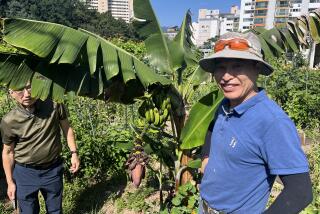Review: Artist’s simulated banana grove is a stinking indictment of American corporate greed
Walk into “Video Art in Latin America” at LAXART and you’ll wonder: Why does it smell like rotten bananas in here?
The gallery’s contribution to the constellation of exhibitions known as Pacific Standard Time: LA/LA is a sprawling survey of video from the 1970s to the present. Deftly curated by the Getty Research Institute’s Glenn Phillips and scholar Elena Shtromberg, it is designed to be experienced on multiple levels, one of which is unexpectedly olfactory.
SIGN UP for the free Essential Arts & Culture newsletter »
That sickly sweet aroma, edged with the tang of decay, comes from “Musa paradisiaca,” a large installation by Colombian artist José Alejandro Restrepo. (The title is the Latin name for a type of edible banana.) Quietly dominating the central gallery is a hanging garden of banana tree stems, each one studded with many, many bunches of bananas. The fruits are in various stages of decay, but most are little more than shriveled black nubs. In the large, darkened gallery, the stems are a haunting presence, like chunks of meat hung up to cure, or more disturbing, hanging bodies.
This last association turns out to be apt. Dangling from the bottom of several stems are tiny cathode ray tubes, one per stem. The screens are turned downward, and the only way to see what’s playing is by looking into a small, round mirror positioned on the floor. It takes a moment to find the right viewing angle, which often involves placing one’s face in awkward proximity to rotting fruit. The reflected video image feels fugitive: small, partial, grainy in black and white. A small shift in position, and it disappears from view. Still, it doesn’t take long to recognize that it’s documentary footage of dead bodies.
The bodies are those of banana plantation workers who went on strike or protested exploitative labor practices. One such strike in 1928 and 1929 resulted in killings by the Colombian military. The Colombian government ordered the attack, but it was protecting the interests of an American firm, the United Fruit Co., and by extension, the anti-communist agenda of the U.S.
Restrepo’s strung-up, decaying bananas are a palpable, physical reminder of the death toll. They also make a statement about the rotten, greed-fueled agendas behind one of our most popular fruits. The work is an encapsulation of the tangled histories of Los Angeles and Latin America, histories that Pacific Standard Time: LA/LA is designed to unearth.
LAXART, 7000 Santa Monica Blvd., L.A. Through Dec. 16; closed Sundays and Mondays. (323) 871-4140, www.laxart.org
You can find other PST: LA/LA coverage at latimes.com/pst.
MORE ART NEWS AND REVIEWS:
Hollywood & Highland censors sculpture in response to Weinstein scandal
Performance artist Karen Finley inhabits Trump and talks Weinstein
Bellini masterpieces make for one of the year’s best museum shows
More to Read
The biggest entertainment stories
Get our big stories about Hollywood, film, television, music, arts, culture and more right in your inbox as soon as they publish.
You may occasionally receive promotional content from the Los Angeles Times.










